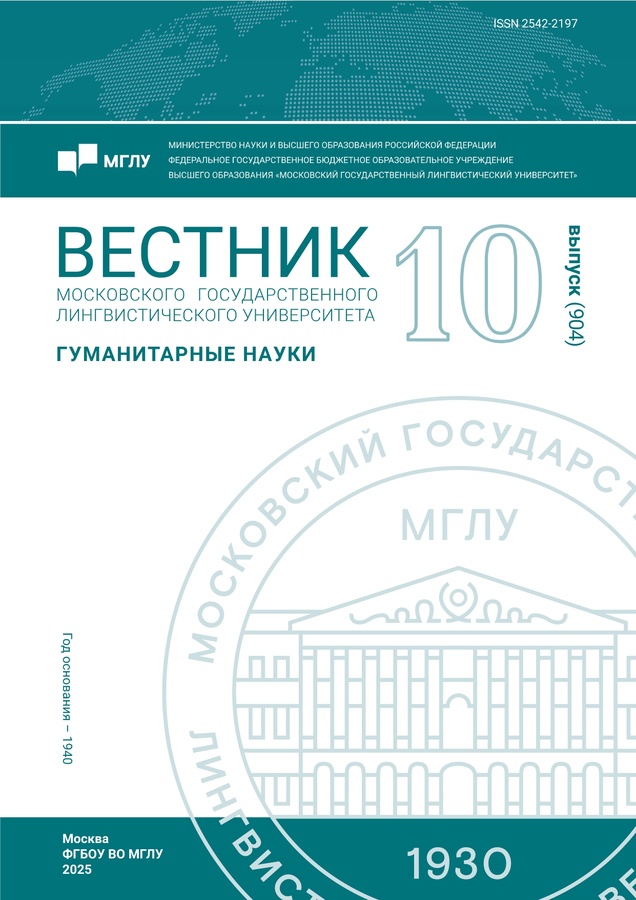Reflection of the Gender Category in the First Scientific Works of the XVI Century: Historical and Linguistic Analysis of Early Grammatical Descriptions
- Autores: Ladonkina V.N.1
-
Afiliações:
- Moscow State Linguistic University
- Edição: Nº 10(904) (2025)
- Páginas: 32-39
- Seção: Linguistics
- URL: https://journal-vniispk.ru/2542-2197/article/view/352243
- ID: 352243
Citar
Texto integral
Resumo
The present study is based on the historical and linguistic analysis of the gender category in the French language of the XVI century, presented in the grammatical treatises by J. Palsgrave, J. Dubois and L. Maigret. The purpose of the work is to identify key trends in the development of the genus category and the causes of variation in generic usage (genus dubium). The methodology includes a comparative analysis of the theoretical provisions and empirical data presented in the works of these authors. The results of the study demonstrate the influence of the Latin language, phonetic changes and semantic factors on the formation of the gender system, as well as the lack of strict codification as the cause of variability. The contribution of the analysis of early grammatical descriptions to the understanding of the processes of normalization of the French language and the mechanisms of linguistic change is emphasized.
Palavras-chave
Sobre autores
Victoria Ladonkina
Moscow State Linguistic University
Autor responsável pela correspondência
Email: ladonkina-v@mail.ru
Lecturer at the Department of the French language, Faculty of translation and interpreting
RússiaBibliografia
- Manuhina, A. O. (2022). Vanitas v srednefrantsuzskom romane “Chevalier errant” Tommazo Salutstso (evolyutsiya “kodeksa chesti rytsarya” v XIV veke) = Vanitas in the Middle French novel “Chevalier errant” by Tommaso Saluzzo (the evolution of the “knight’s code of honor” in the 14th century). Vestnik of Moscow State Linguistic University. Humanities, 13(807), 11–20. (In Russ.)
- Sahai, S.Y., Sharma, D. (2021). Predicting and explaining French grammatical gender. In Proceedings of the Third Workshop on Computational Typology and Multilingual NLP (pp. 90–96). Association for Computational Linguistics.
- Doyen, E., Todirascu, A. (2025). Genre: A French Gender-Neutral Rewriting System Using Collective Nouns. In Findings of the Association for Computational Linguistics (pp. 7889–7909). Vienna.
- Ulianitckaia, L. A. (2020). Feminizatsiya yazyka v sotsial’no-politicheskom prostranstve Rossii i Frantsii = Language Feminisation in Sociopolitical Space of Russia and France. Discourse, 6(3), 137–154. (In Russ.)
- Dokulin, M. (1967). K voprosu o morfologicheskoi kategorii = On the question of morphological category. In Voprosy yazykoznaniya (pp. 5–6). Moscow. (In Russ.)
- Potebnya, A. A. (1899). Iz zapisok po russkoi grammatike = From Notes on Russian Grammar (vol. 3). Moscow: Izdatelstvo Akademii Nauk USSR. (In Russ.)
- Peshkovsky, A. M. (1956). Russkii Sintaksis v Nauchnom Osveshchenii = Russian Syntax in a Scientific Light. Moscow: Gosudarstvennoe izdatelstvo. (In Russ.)
- Damourette, J., Pichon, E. (1911–1927). Essai de Grammaire de la Langue Française. Paris: Collection des Linguistes Contemporains. Tome Premier.
- Moc, Q. J. (1968). Contribution à l’étude des catégories morphologiques du genre et de nombre dans le français par l’actuel. Paris: Mouton The Hague.
- Kukenheim, L. (1951). Histoire de la langue française. Leiden: Univ. Pers.
Arquivos suplementares










